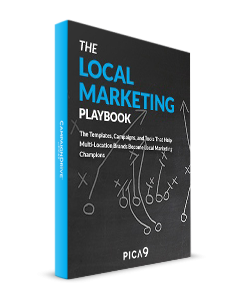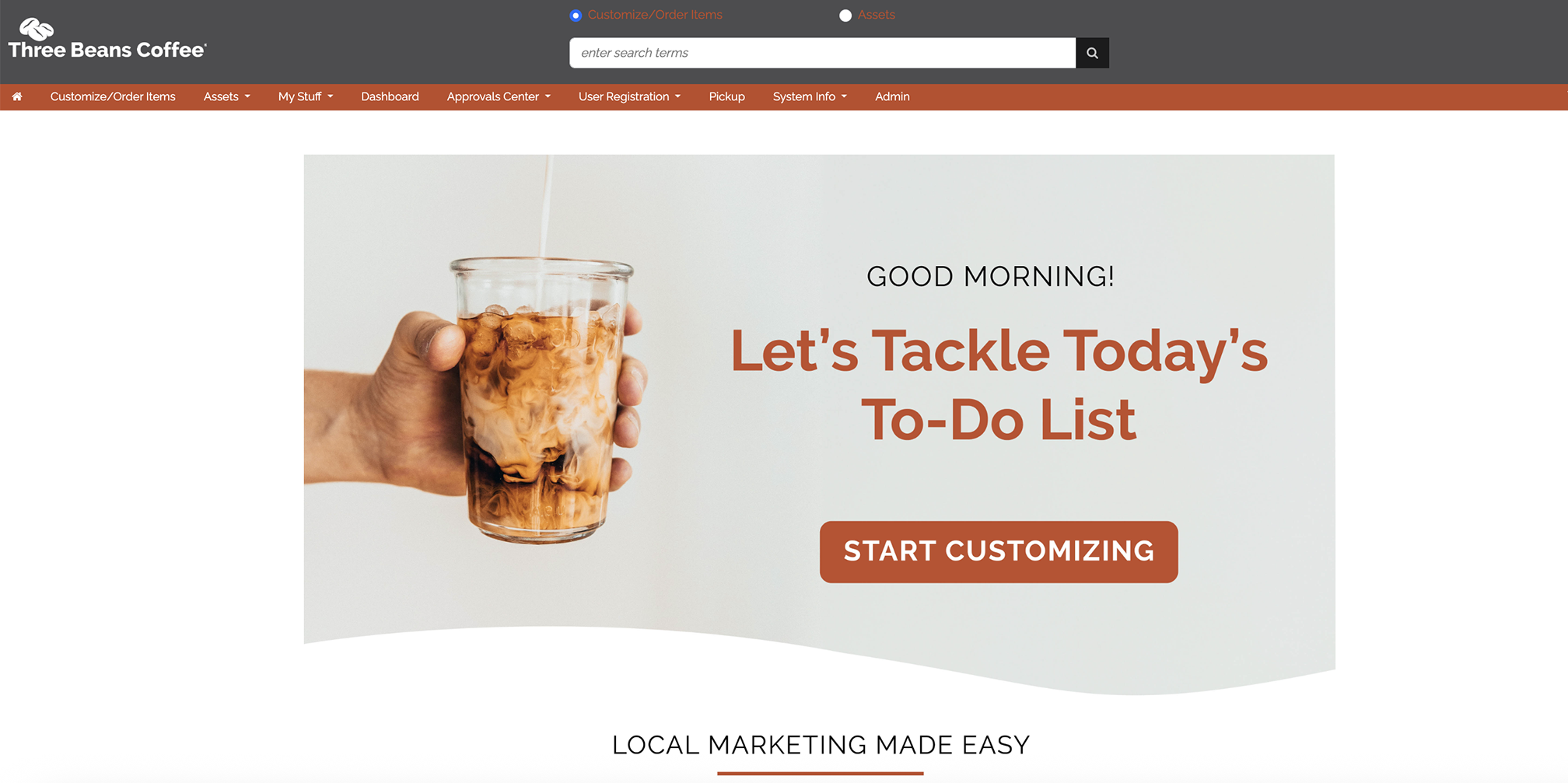Veterans in advertising and marketing have long said that the only thing harder than building a great brand is maintaining it. Every day, in countless different ways, opportunities arise for the brand to become diluted through inconsistent brand execution.
This is especially true for distributed marketing organizations, where a network of local operators (franchisees, dealers, resellers, etc.) play a big role in activating the brand, through in-store, near-store, and locally initiated marketing activities.
That’s why iconic brands have always invested in developing brand compliance disciplines that preserve and enhance brand consistency—so that every action, no matter how small, adds value to the brand.
Definition of Brand Compliance
Brand compliance is the method businesses utilize when creating messaging, to ensure that the message doesn’t negate or stray from the business's core brand standards, values, and visual identity.
Proper brand compliance means delivering consistent messaging in regional and local campaigns by ensuring:
- Brand look and feel remains consistent in all communications— traditional and digital.
- Brand communications are always executed with the correct fonts, colors, logos, and imagery.
- Brand and product messaging uses the same tone and voice across platforms, to create and maintain a distinctive brand personality.
The Costs of Ineffective Brand Compliance
Brands that ignore the compliance problem often find themselves caught in a vicious cycle of marketing chaos. Because brand communications are not consistent, they are less effective in winning attention and building relationships with customers. To combat these ill effects, local marketers often begin experimenting independently, further eroding the consistency of the brand. Trust and collaboration between headquarters and field-based marketers begin to wane, and the ability to mount and coordinate campaigns falls. If allowed to continue, this erosion can lead to declines in satisfaction, not only among customers but also among the brand’s local selling partners.
A Brief History of Brand Compliance
The modern business of branding dates back to the 1940s when Walter Landor founded the world’s leading brand consultancy—Landor Associates—headquartered on a steamboat in San Francisco Bay.
It was those early Landor teams that first codified the customer-focused, research-based approach to brand development that is responsible for virtually all the most iconic brands we know today. And they did that ground-breaking work by creating some of the first brand style guides, or brand bibles—and sorting out what those governing documents should include.
The Brand Bible: Do’s and Don’ts
Early on in the modern history of branding, the notion of a brand standards “bible” became core to the discipline. Brand bibles were authored by the creative authorities who first defined and articulated the brand, and were deployed across the enterprise—often at enormous effort and expense.
Periodically, the brand bible would be subjected to brand audit, to see how well its rules were being followed, and what impact the brand was having on the relationship between the company and its customers. The scope of the bible increased, moving beyond the mechanical aspects of typography and layout, to issues of voice, tone and tenor, and brand personality. The notion of a bible, used playfully at first, soon came to be taken much more literally, as the “religion” of the brand took root.
Examples of Highly Disciplined Brands
There is no serious doubt or dissent among students of business that this focus on brand discipline had a massively positive impact on the organizations that pursued it seriously. In every industry from manufacturing to media, to medicine and beyond, disciplined strategic branding helped to produce market-leading gains in revenues and company value. In fact, the science of brand valuation first arose in the 60s and 70s precisely because the brand had become an incredibly important asset on company balance sheets.
Specific examples of highly disciplined brands are legion, of course—but a few examples here may help to drive home the vital role that brand-compliance programs have played over the years.
FedEx
At the FedEx headquarters in Memphis, it’s often said that staff members “bleed purple”, a reference to the company’s primary brand color and a testament to how deeply brand voice has soaked into the corporate culture. From the iconic FedEx logo to the livery of the ubiquitous FedEx trucks, the company has made the brand a cultural icon. With this emphasis on brand discipline, the company has also achieved one of the more challenging feats in the marketing realms: the successful creation of close to a dozen “sub-brands” (FedEx Ground, FedEx Freight, FedEx Office, etc.), each drawing strength from the parent without diluting or confusing the master brand’s awareness and appeal. That same disciplined approach applies to the B2B side of the FedEx business, where sales collateral are subjected to the same kind of brand scrutiny that a broadcast spot or national newspaper ad would receive. These are just a few of the many reasons why the FedEx brand was valued in excess of $2.5 billion, growing more than 33% in 2018.
Chick-fil-A
Great brand compliance means paying attention to every detail of the customer experience—and arguably no company has done this more consistently than Chick-fil-A. While tripling sales from $2.5 billion to $10.5 billion over the past decade, the company has vaulted itself into the #3 position in the quick service restaurant category, with per-store sales that are more than three times greater than its largest direct competitor. And the number one reason for this phenomenal growth is the way in which Chick-fil-A operators embody and activate the brand—not just in communications, but in every aspect of employee training, menu planning, and day-to-day operations.
The Ritz-Carlton
With nearly 200 properties around the globe, The Ritz-Carlton Hotel Company has in many ways defined the parameters of a “luxury” brand. Team members at every Ritz-Carlton property are referred to as “Ladies and Gentlemen”, and they are encouraged and supported to live up to those terms in every aspect of their service to guests. This is a great example of how brand compliance is more than just a set of rules; it’s a way of being, doing, and moving through your day. You can also see the dedication to brand discipline in the way that each property in the collection has a version of the logo dedicated to it—a graphic element that speaks to individuality but still supports the brand promise.
Enforcing Brand Guidelines: A Tall Order
Almost as soon as a brand defines its rules and guidelines, those standards start to get broken. Usually, these violations aren’t the result of any deliberate intent. Rather, they’re innocent mistakes, often made by business users who haven’t been trained in the nuances of typography and graphic design sufficiently to know that they’re even going astray.
To guard against this erosion, most brands strive to create a culture of brand policing and brand monitoring. Sometimes, the policing job falls to the marketing department; in other cases, the agency of record took on that job.
But whether the “cops on the beat” are internal or external, the impact on marketing communications is the same—brand policing makes marketing operations more formal and more bureaucratic, and drives both costs and turnaround times higher.
There’s another drawback to the policing method: It encourages local operators to avoid or evade the system entirely. “Better to ask forgiveness than to ask for permission,” is a line I’ve heard from many an entrepreneurial franchisee—and it’s a sign that the brand is getting diluted by “rogue” behavior.
In the 1990s, with the rise of the Internet, the brand compliance culture came under new pressure. New media types (emails and banner ads, and search campaigns) and highly targeted media strategies caused the number of creative executions to skyrocket.
Increased competition, meanwhile, meant that turnaround times for major campaigns needed to fall from weeks to days—and sometimes hours. The classic approval processes began to creak and ultimately collapsed under their bureaucratic weight. And very often, brand consistency began to suffer.
The Rise of Web-Enabled Brand Compliance Systems
In the late-90s and early 00s, a new set of brand-compliance tools, or marketing resource management systems, began to emerge. These systems used the capabilities of the Web to curate and deploy brand marketing assets so that people across the organization could utilize those assets securely in the knowledge that they were complying with brand standards and rules. Approval processes moved online too, shaving days and weeks off of turnaround times. Technology, it was clear, could help to tame the brand-compliance problem without bringing marketing operations to a grinding halt.
In some cases, brand-compliance systems were built on top of old digital asset management tools, breathing new life into systems that were years, sometimes decades old. Soon, a new generation of brand compliance tools emerged, capitalizing on the latest advances in cloud infrastructure and SaaS models to offer greater flexibility, greater simplicity, and lower costs. The most successful of these systems shared a core set of brand-compliance tools in common:
- Curated, Marketing-Focused Asset Libraries to help deploy brand-compliant assets directly to the teams that need to use them, both within marketing departments and in the broader organization.
- Logo Management Capabilities which ensure that essential brand components are current and implemented properly.
- Dynamic Templating Tools that automatically ensure brand-compliant executions in terms of typography, layout, color usage, and other design details.
- Brand Compliant Content/Messaging Libraries which ensure that messaging regarding the brand, and its products/services are consistent with both company policy and applicable rules and regulations.
- Approval Loops and Workflows that ensure content is properly reviewed prior to release and that external partners receive materials in the proper format for high-quality execution.
- Real Time Reporting that helps brand managers to keep track of the use of brand assets and to utilize the insights gained to guide ongoing creative development.
Beyond Brand Cops: The Empowered Brand Culture
Today, with the benefit of SaaS-based brand management systems, brands are able to achieve a combination of brand compliance and marketing-operations efficiency that was largely out of reach just a decade or so before. Studies of local marketing savings engendered by these systems have shown cost reductions of as much as 80-85%. Turnaround times for many local marketing initiatives have come down by similar proportions, helping to make brands more nimble, and more disciplined at the same time.
c systems to replace a culture of enforcement with a promise of empowerment. Rather than restricting the ability of field-based marketers and other business users to create marketing communications materials, these systems encourage the act of creation—with carefully defined and technologically guided “guard rails.” This makes all users of the system partners in the creation and protection of brand voice, with a greater stake in—and more immediate benefits from—the proper use of the brand.
Resistance to Brand Compliance Systems: When the Trend Is Not A Friend.
The cost and cultural advantages of brand-compliance systems have helped to spark a steady migration among major brands toward this new empowered model. But critics and resistors remain—mostly among the creative teams and agencies that stand to see their work volumes decrease as a result of the “democratization” of marketing.
Repeated experience shows, however, that when creative leaders embrace brand-compliance technologies, they can actually have an even greater impact on the power of the brand than if they continued to pursue the now-outmoded command and control model.
This is because, in the hands of a brand leader, brand-compliance systems can deploy more than just assets and templates. They can actually help to deploy a depth of insight and marketing intelligence that users in the field would not otherwise be able to access.
This is one reason why more and more creative agencies are coming to see as part of their brief the administration and curation of brand compliance systems on behalf of their clients. What once might have been seen as a purely administrative function has taken on a more strategic importance. And given the recent reductions in corporate staff during the pandemic, brand compliance is a job that could easily fall to the wayside—with the potential for significant negative impact over the long haul—if agency partners do not step up and offer to play that role.
Achieve Global Brand Compliance Easily With CampaignDrive By Pica9
CampaignDrive by Pica9 is one of the best brand compliance solutions that empowers multi-located brands to deploy brand-compliant, localized marketing campaigns across every location. Learn more.







